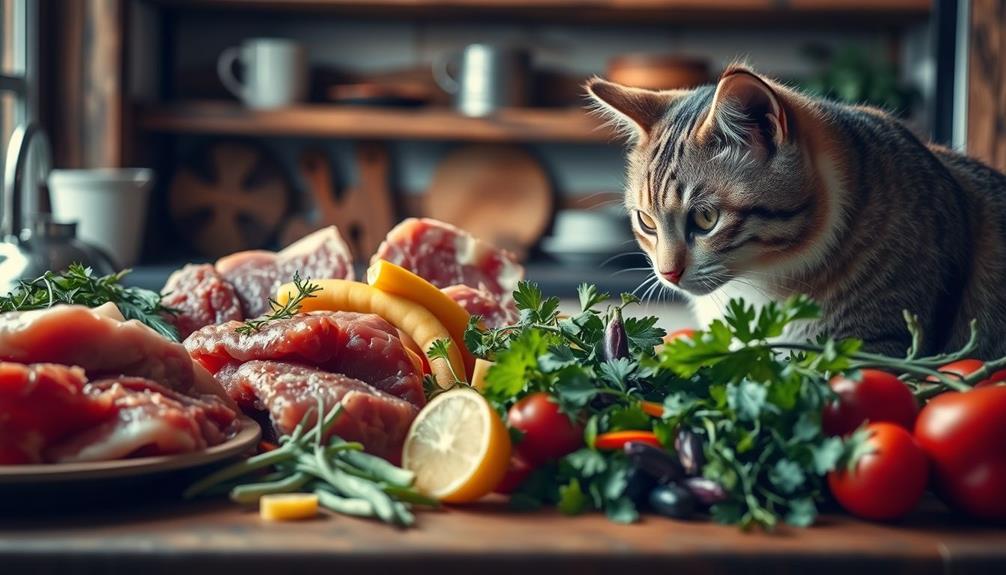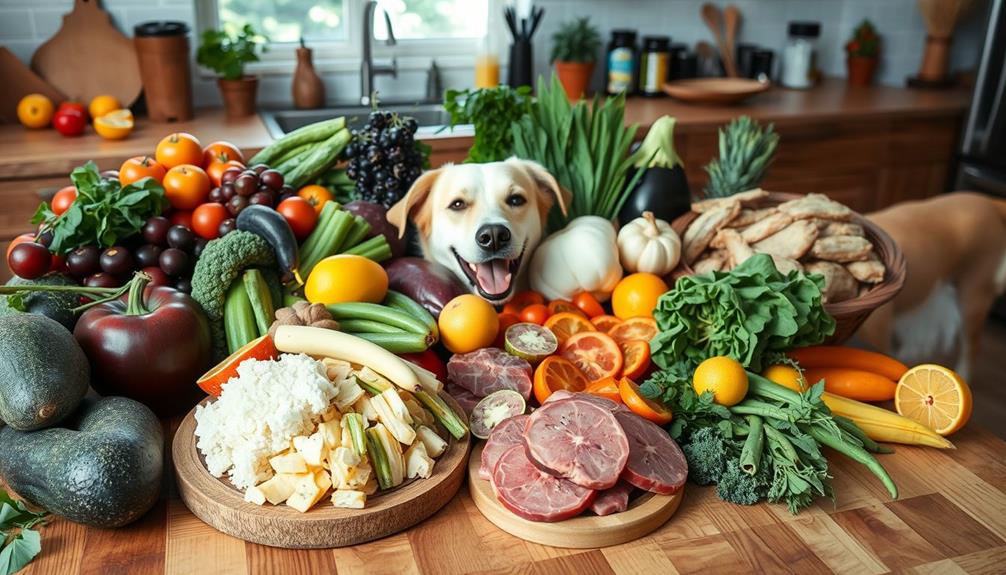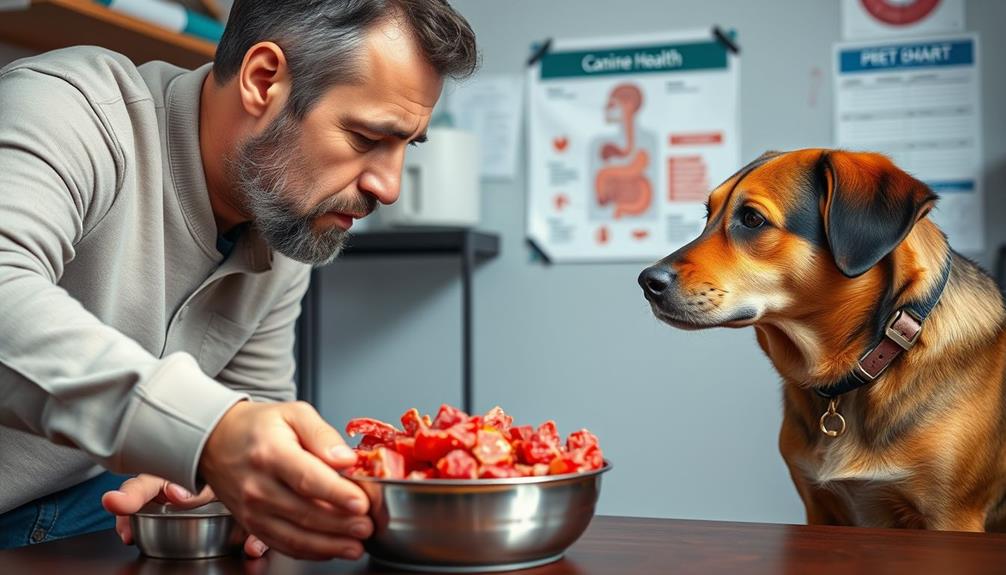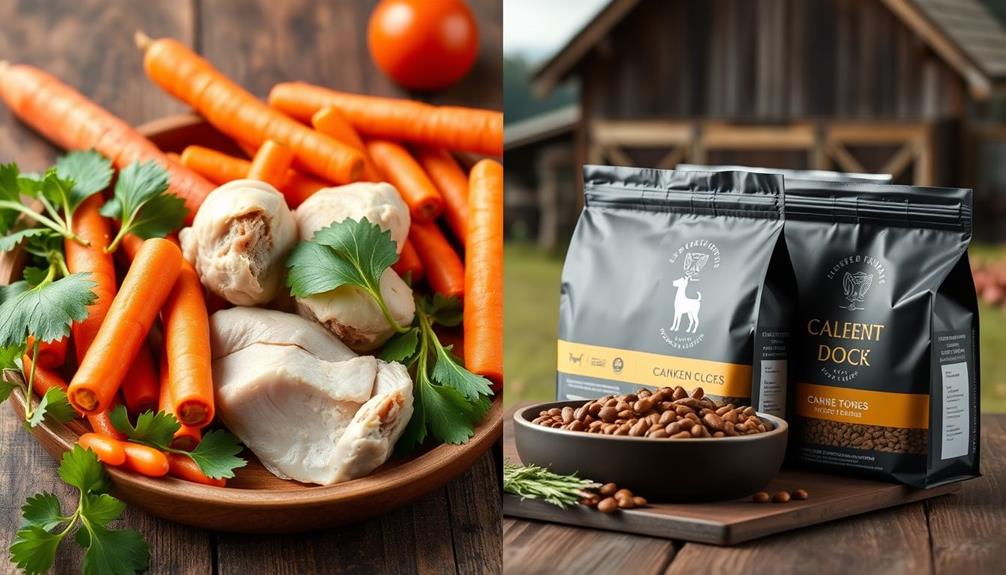You can feed your cat raw food, but it takes careful planning to guarantee a balanced diet. Opt for high-quality muscle meat, organ meat, and ground bones while avoiding homemade recipes that may lack essential nutrients. Consult your vet to create a safe, nutritious plan and consider commercial raw diets that follow recognized guidelines. Keep food handling safe to reduce health risks, and shift your cat gradually to avoid digestive upset. Regularly monitor their health and adjust their diet as necessary. There's plenty more to explore about raw feeding that could help you make informed choices. Can cats eat raw food? Many experts believe that raw food can provide numerous health benefits for cats, such as improved digestion, healthier coat, and increased energy. However, it is essential to research and understand the potential risks and benefits before making the switch. Always consult with a vet to ensure that the raw diet is suitable for your cat’s individual needs and health status. Additionally, monitor their weight, energy levels, and overall well-being to make sure that they are thriving on their new diet.
Key Takeaways
- Consult with a veterinarian to ensure a balanced raw diet that meets your cat's nutritional needs and health conditions.
- Gradually transition to raw food over a week to prevent digestive upset and monitor your cat's health during the change.
- Choose high-quality protein sources and include a variety of meats, muscle, organ, and raw bones for a complete diet.
- Practice safe handling of raw food, including proper storage, thawing, and cleanliness to minimize the risk of foodborne illnesses.
- Regularly monitor your cat's weight, coat condition, and energy levels, and schedule veterinary check-ups for ongoing health assessment.
Understanding Raw Food Diet
What does a raw food diet for cats really entail? A raw food diet (RFD) primarily consists of raw muscle meat, organ meat, and ground bones, designed to mimic the natural diet of wild cats.
When you're considering feeding your cat this way, it's important to guarantee that the diet is complete and balanced. Incorporating a variety of ingredients is vital to provide adequate nutrients, similar to the principles of effective strategies for weight loss that emphasize balance and variety.
While you might think that fresh meats like chicken and fish are enough, the nutritional adequacy of these diets is often debated by veterinarians and animal nutrition experts.
Homemade raw food diets can easily fall short of essential nutrients, leading to potential deficiencies. That's why it's imperative to consult with a veterinarian before you start. They can help you create a formulation that meets your cat's nutritional needs.
On the other hand, commercially prepared raw diets often follow WSAVA guidelines and undergo feeding trials, making them a safer choice compared to homemade versions.
Ultimately, understanding the components of a raw food diet is vital for feeding your cat in a way that promotes health and well-being.
Benefits of Raw Feeding
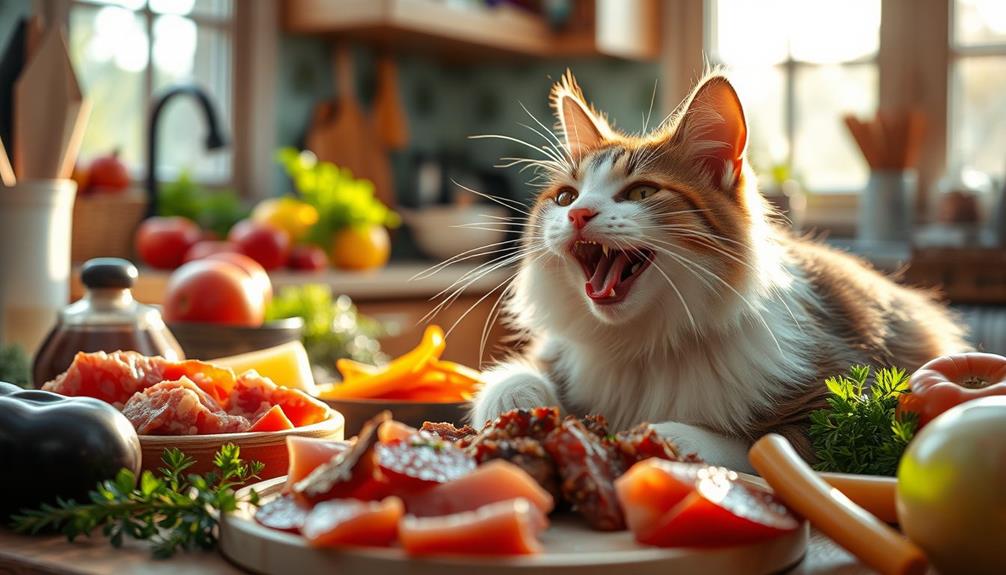
Have you ever wondered how a raw food diet can benefit your cat? A raw diet can greatly enhance your cat's overall health in multiple ways. Here are some of the key benefits of feeding raw:
| Benefit | Description | Impact on Health |
|---|---|---|
| Dental Health | Chewing raw food helps reduce plaque and tartar. | Promotes healthier teeth and gums. |
| Skin and Coat Condition | Improved nutrition leads to a shinier coat and less shedding. | Boosts appearance and comfort. |
| Hydration | Higher moisture content supports urinary health. | Aids in preventing urinary issues. |
Additionally, nutrient-dense raw diets provide essential amino acids, vitamins, and minerals that contribute to your cat's health and energy levels. With lower carbohydrate levels, raw feeding can also help alleviate obesity and chronic health issues, making it easier for your cat to maintain a healthy weight. By switching to a raw diet, you're not only feeding your cat but also investing in their long-term health and happiness.
Nutritional Balance in Raw Diets

When feeding your cat a raw diet, ensuring nutritional balance is key for their health.
It's important to reflect on the potential risks of financial mistakes that come with improper meal planning, just as one would with budgeting. Without proper formulation or veterinary guidance, you risk introducing deficiencies that can harm their well-being.
Commercial raw food formulas can help, but if you're opting for homemade meals, it's crucial to include a variety of ingredients to meet all their nutritional needs.
Nutrient Deficiency Risks
Feeding your cat a raw diet can come with significant risks if it's not properly balanced. Many homemade raw food diets lack essential nutrients, leading to nutritional deficiencies that can severely impact your cat's health. For instance, a deficiency in thiamine can affect nerve and brain function, metabolism, and even bone strength.
Unlike homemade options, commercially prepared raw food diets often meet AAFCO nutrient guidelines, ensuring they provide a balanced diet for your feline friend. Additionally, like juice diets that may lead to nutrient deficiencies if not balanced, raw diets require careful consideration of nutrient content to avoid health risks nutritional balance in raw diets.
When you opt for a raw diet, it's important to understand that a lack of vitamins and minerals can lead to serious health issues. Essential nutrients are critical for your cat's overall wellbeing, and failing to include them can result in long-term consequences. This highlights the importance of balanced formulations in raw food diets.
To mitigate these risks, consider collaborating with a veterinarian. They can help you create a diet that meets all your cat's nutritional needs, ensuring a healthier lifestyle. By taking the right steps, you can provide a raw diet that supports your cat's health without compromising their nutrient intake.
Importance of Veterinary Guidance
Steering through the complexities of a raw food diet requires careful planning, especially when it comes to guaranteeing nutritional balance.
Collaborating with your veterinarian is essential for tailoring a raw food diet that meets your cat's specific life stage and health status.
Many homemade diets often lack essential nutrients, which can lead to deficiencies that adversely affect your cat's well-being.
Additionally, understanding the importance of financial planning for care can play a role in guaranteeing you can provide the best possible diet for your pet.
Consider these points when seeking veterinary guidance:
- Tailored Nutritional Plans: Your vet can help you create a diet that meets all nutritional requirements.
- Monitoring Health Status: Regular check-ups guarantee your cat remains healthy and that their diet doesn't lead to imbalances.
- Avoiding Common Pitfalls: Vets can advise on proper ingredient ratios and highlight harmful components to avoid.
Balanced Raw Food Formulas
Achieving a balanced raw food diet for your cat hinges on understanding the right mix of ingredients. A proper ratio of muscle meat, organ meat, and ground bones is critical to meet their nutritional needs.
It's important to evaluate the potential health risks of an unbalanced diet, similar to how hamster care emphasizes proper nutrition. If you're contemplating homemade raw food, it's essential to guarantee that your cat food includes all necessary nutrients.
Commercially prepared raw diets often adhere to AAFCO nutrient guidelines, making them a reliable option for balanced nutrition. Improperly balanced raw diets can lead to nutrient deficiencies, such as thiamine, which can seriously affect your cat's nerve, brain, and overall metabolism.
To avoid these issues, collaborate with a veterinarian or pet nutritionist when preparing homemade meals. They can help you formulate a plan that meets all of your cat's dietary requirements.
Additionally, regularly evaluating the components of your cat food against National Research Council (NRC) guidelines is important to maintain nutritional adequacy.
Safety Concerns With Raw Food
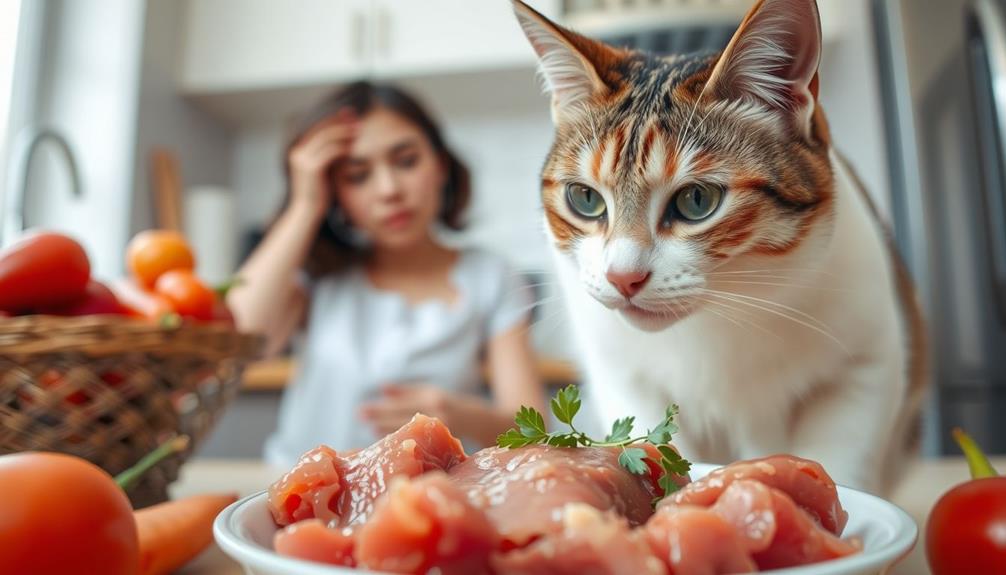
When you consider a raw food diet for your cat, it's vital to be aware of the risks associated with bacterial contamination.
Pathogens like Salmonella and E. coli can pose serious health threats to both your feline friend and your household.
Additionally, selecting the right raw food sources and practicing safe handling techniques can greatly reduce these risks.
Regularly checking for common types of cold medications can also help prevent the onset of health issues in your pet.
Practicing safe handling techniques is essential to minimize these risks and keep everyone safe.
Bacterial Contamination Risks
Feeding your cat raw food can be enticing, but it's imperative to understand the risks associated with bacterial contamination. Raw food is vulnerable to harmful bacteria such as Salmonella, E. coli, and Listeria, which can threaten both your cat's health and your own.
Individuals with certain health conditions, such as those involving emotional dysregulation, may be particularly susceptible to foodborne illnesses, making it even more vital to guarantee food safety diagnosis is based on DSM-5 criteria. While cats have shorter gastrointestinal tracts, making them less likely to suffer severe illness, the risk of cross-contamination in your home is a significant concern.
To help you navigate these risks, consider the following:
- Bacterial Exposure: Raw food can harbor dangerous pathogens, making food safety paramount.
- Health Risks: Infected food can lead to serious illness in cats and humans alike.
- Precautionary Measures: Be vigilant about storage and handling practices to minimize contamination.
The CDC and AVMA strongly advise against feeding raw meat due to the potential for foodborne pathogens. If you choose to go the raw food route, look for products treated with High Pressure Processing (HPP) to improve safety.
Ultimately, understanding bacterial contamination risks is vital for guaranteeing a safe feeding experience for both you and your feline friend.
Safe Handling Practices
Understanding the risks of bacterial contamination is just the beginning; safe handling practices are vital for mitigating those risks. When you're preparing raw food for your cat, proper storage is imperative. Always keep raw meat frozen until you need it, and remember to thaw it in the refrigerator. This helps prevent harmful bacteria from growing.
Additionally, consider incorporating essential oils for improved health to create a more holistic approach to your cat's well-being.
After handling raw meat, wash your hands and surfaces thoroughly. This minimizes the risk of cross-contamination with harmful pathogens like Salmonella and E. coli, which can affect both you and your cat.
Once thawed, raw food should be consumed within four days to guarantee safety and freshness, and never refreeze thawed food.
Consider using products that employ High Pressure Processing (HPP)—this can enhance the safety of raw diets by reducing the presence of harmful bacteria without cooking the food.
Transitioning to Raw Food
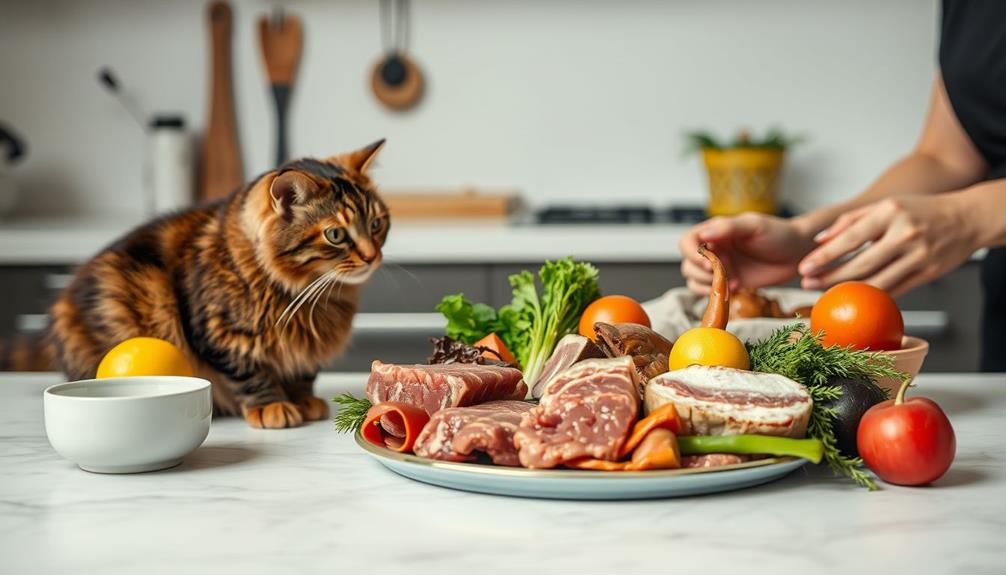
Shifting your cat to a raw food diet can be a rewarding experience, but it requires thoughtfulness and patience. A gradual change is key; over the course of a week, decrease the old food while increasing the new to prevent digestive upset.
Always monitor your cat's weight and overall health during this period to guarantee they're adjusting well to the new diet. Incorporating a variety of textures and flavors can enhance their interest, similar to how unique beetroot recipes for baby-led weaning encourage exploration in young children.
Here are some tips to make the change smoother:
- Use wide dishes for easier access to the food.
- Sprinkle treats on top of the raw food to entice your cat.
- Add warm water to enhance the aroma and flavor of the meal.
Be flexible in your approach. Some cats may take longer to adjust than others, so adapt based on their response.
Never starve your cat during this change, as going without food for 24 hours or more can cause serious health issues.
With care and attention, your cat will likely embrace the raw food diet, leading to a healthier, happier life.
Essential Ingredients for Raw Feeding
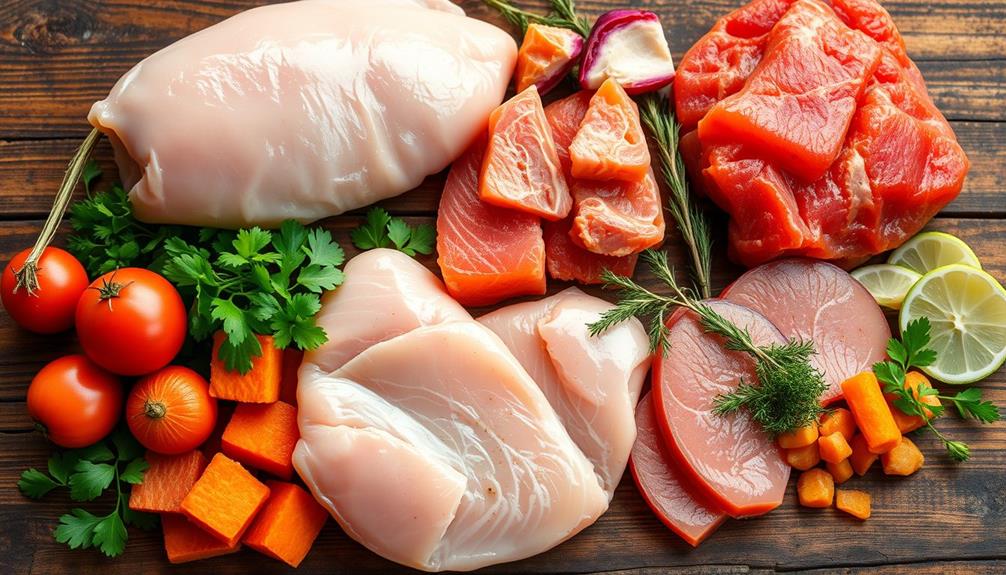
When you're preparing a raw food diet for your cat, understanding the key nutritional components is vital.
Incorporating healthy dog snacks with natural ingredients can also inspire balanced meal choices for your feline friend.
You'll want to guarantee safe ingredient sources and balance the diet properly to meet your feline's needs.
Let's explore what makes up a healthy raw feeding plan.
Key Nutritional Components
Creating a balanced raw food diet for your cat involves focusing on key nutritional components that guarantee their health and vigor.
To make certain your feline friend thrives, prioritize these essential ingredients:
- Muscle meat: This should make up 70-80% of their diet, providing high-quality animal protein essential for energy and overall health.
- Organ meats: Incorporate liver and heart, which are rich in important vitamins and minerals, including taurine. This amino acid is critical for heart and eye health.
- Raw bones: Include these for calcium and phosphorus, necessary for strong bones and metabolic functions.
When formulating your cat's diet, remember that they're obligate carnivores, requiring a substantial amount of animal protein to meet their nutritional needs.
By focusing on these key components, you can create a raw diet that not only meets your cat's energy requirements but also supports their overall well-being.
If you're considering commercially prepared raw diets, keep in mind that these often include added vitamins and minerals, which can help guarantee a complete and balanced meal for different life stages.
Safe Ingredient Sources
Choosing the right ingredient sources is crucial for a safe and nutritious raw food diet for your cat. Start by prioritizing high-quality sources of protein like chicken, turkey, and fish. Make certain they're fresh and free from hormones or antibiotics. Organ meats, such as liver and heart, are important too, as they're packed with essential vitamins and minerals.
Incorporating ground bones provides necessary calcium and phosphorus, but confirm they're raw to avoid splintering hazards. Always source your ingredients from reputable suppliers who adhere to safe handling practices. This minimizes the risk of bacterial contamination, such as Salmonella and E. coli.
Here's a quick reference table to help you choose the right ingredients:
| Ingredient Type | Examples | Nutritional Benefit |
|---|---|---|
| Protein | Chicken, Turkey, Fish | High-quality protein |
| Organ Meats | Liver, Heart | Rich in vitamins/minerals |
| Ground Bones | Raw chicken bones | Calcium and phosphorus |
| Supplements | Fish oil, taurine | Omega-3s and amino acids |
| Reputable Suppliers | Local butcher, farms | Confirms safety standards |
Consult a vet or pet nutritionist to confirm that your selections form a complete diet for your cat.
Balancing Raw Diet
Feeding your cat a balanced raw diet requires careful attention to the right mix of ingredients. A well-rounded raw food diet should include high-quality animal proteins, organ meats, and ground bones to provide essential nutrients.
Here are key components to take into account:
- Taurine-rich ingredients, like heart or liver, to support heart and eye health.
- Calcium sources, such as raw bones or bone meal, for proper bone health.
- Variety of meats (e.g., chicken, beef, fish) to prevent nutrient deficiencies.
Incorporating these elements guarantees your cat gets the essential nutrients they need for peak health.
It's crucial to remember that a balanced raw diet isn't just about meat; it involves the right proportions of proteins, fats, and nutrients. Consulting with a veterinarian or a pet nutritionist can help you tailor the diet to meet AAFCO guidelines, ensuring it's suitable for your cat's specific life stage and health needs.
Common Myths About Raw Diets
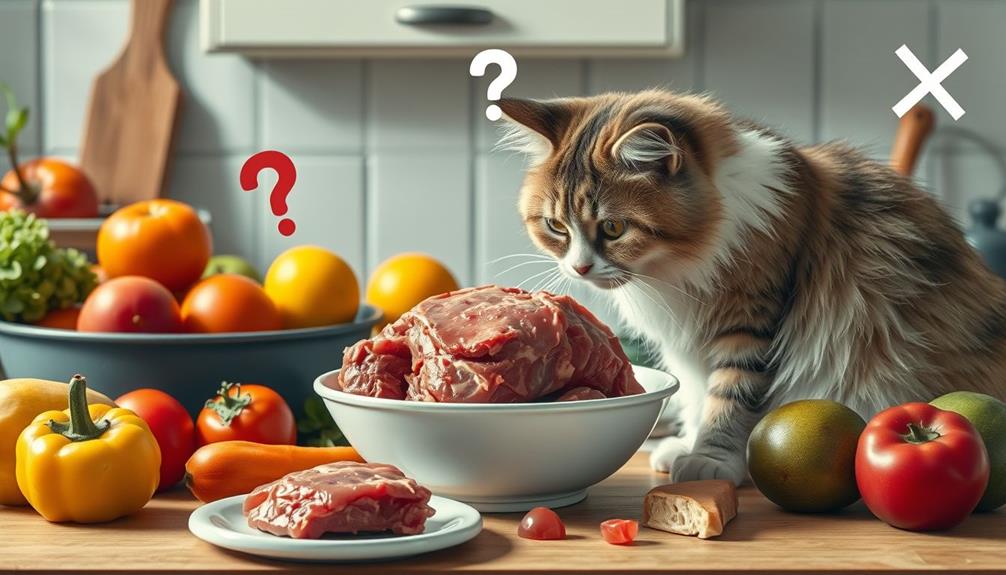
While many cat owners are drawn to the idea of a raw diet for its perceived benefits, several common myths can cloud the reality.
One misconception is that raw diets are inherently more nutritious than cooked foods. In fact, cooking can enhance nutrient availability and digestibility for your cat.
Another myth is that raw food is safer; however, raw diets can harbor harmful bacteria like Salmonella and E. coli, posing significant health risks for both pets and humans.
Many pet owners mistakenly believe all commercially available raw diets are complete and balanced. Without proper veterinary guidance, homemade versions often lack essential nutrients, leading to deficiencies.
Additionally, you might assume raw bones are safe for cats, but unground bones can cause intestinal blockages or lacerations, making their use risky.
Lastly, there's a prevailing belief that feeding raw food leads to better dental health. While chewing raw meat may help, it doesn't guarantee oral hygiene, and regular dental care is still necessary.
Monitoring Your Cat's Health

Monitoring your cat's health is essential when adapting to a raw food diet. You'll want to keep a close eye on several aspects to guarantee your feline friend is thriving. Start by regularly monitoring your cat's weight and body condition. They should generally eat about 2-2.5% of their body weight daily.
Pay attention to the following:
- Changes in coat condition and energy levels
- Signs of digestive issues like diarrhea or vomiting
- Potential nutrient deficiencies, such as lethargy
As you observe these factors, look for any changes in your cat's demeanor. A raw diet can positively impact dental health by reducing plaque, but regular check-ups are still critical.
If you notice any concerning symptoms or signs of nutrient deficiencies, it's wise to consult a veterinarian.
Always remember that the adaptation to a raw food diet can come with challenges, but by actively monitoring your cat's health, you can make necessary adjustments to their diet to guarantee they remain happy and healthy.
Your proactive approach will help you catch any issues early and keep your cat on track.
Veterinary Guidance and Support
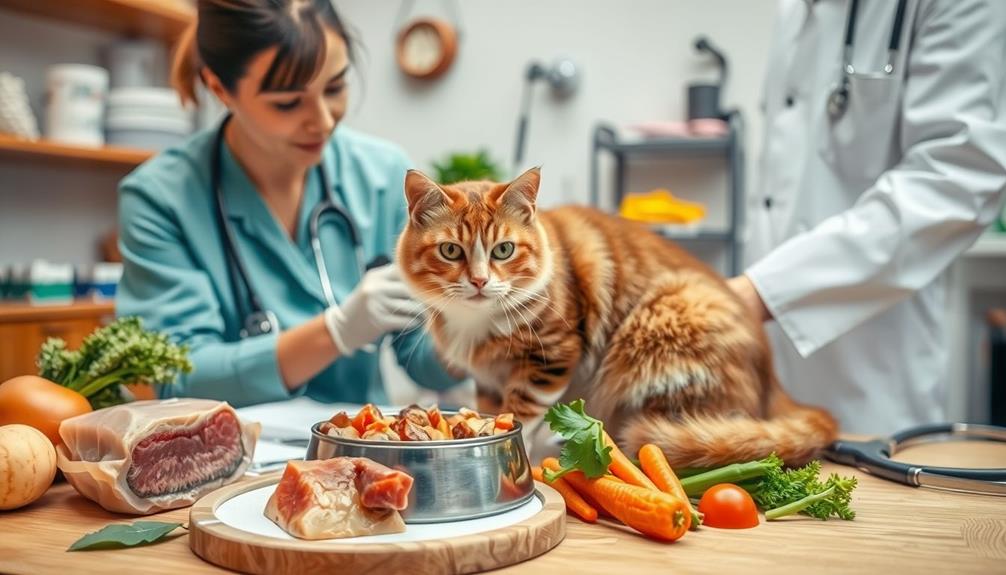
Consulting with a veterinarian can make all the difference when you're considering a raw food diet for your cat. They provide essential veterinary guidance on nutritional adequacy, helping you formulate a balanced diet that meets all of your cat's needs.
Here's a quick overview of what you can expect from veterinary support:
| Aspect | Description |
|---|---|
| Nutritional Evaluation | Evaluating your cat's current health and needs |
| Diet Formulation | Creating balanced raw diets following AAFCO guidelines |
| Monitoring | Regular check-ups to track health and detect deficiencies |
| Recommendations | Suggesting commercially prepared raw diets |
| Risk Management | Guiding safe handling and storage practices |
Veterinary nutritionists are particularly helpful in ensuring your raw food diet is safe and nutritionally complete. They can recommend commercially prepared raw diets that are designed to meet your cat's specific nutritional requirements. Regular veterinary visits will help you monitor your cat's health, keeping an eye out for any signs of deficiencies or other issues. So, don't hesitate to seek professional guidance—it's essential for your cat's well-being on a raw food diet.
Community Resources and Support

For cat owners considering a raw food diet, community resources and support can be invaluable. Engaging with others who share your interest in raw feeding allows you to gain insights, share experiences, and access expert information.
Online platforms like The Pack and various social media groups can be great places to start.
Here are some key resources to explore:
- Online communities: Connect with fellow cat owners to discuss raw feeding practices and share tips.
- Local raw feeding groups: Meet others in your area who can recommend ingredient sources and best practices.
- Educational articles: Access pet health websites that cover the benefits and risks of raw diets for cats.
Frequently Asked Questions
Can Cats Eat Raw Chicken Tips?
Yes, cats can eat raw chicken, but make certain it's sourced safely. Only offer muscle meat, organ meats, and ground bones. Consult your vet, introduce it gradually, and avoid skin or unground bones to prevent hazards.
What Should I Add to My Cat's Raw Food?
You should add high-quality protein sources like muscle and organ meat, along with ground bones. Don't forget essential vitamins, omega-3s for coat health, and some fiber to aid digestion. Always consult a vet for guidance.
Can I Feed My Cat Raw Food Everyday?
Did you know that around 70% of veterinarians caution against daily raw feeding? If you're considering it, make certain the diet's balanced, monitor your cat's health closely, and consult a vet to avoid potential risks.
Why Don T Vets Recommend a Raw Diet for Cats?
Vets don't recommend raw diets for cats due to serious health risks. Bacterial contamination, nutrient deficiencies, and potential injuries from bones make these diets unsafe. It's best to stick with balanced, commercially prepared options for your cat's health.
Conclusion
In the grand adventure of feeding your cat, raw food can be a treasure trove of benefits if approached wisely. Just like a well-worn map leads to hidden gems, paying attention to nutritional balance and safety can guide you toward a healthier feline. As you commence on this journey, remember to consult your vet and stay informed—after all, even the wisest explorers seek guidance. With patience and care, you'll both enjoy this new chapter in your cat's diet!

